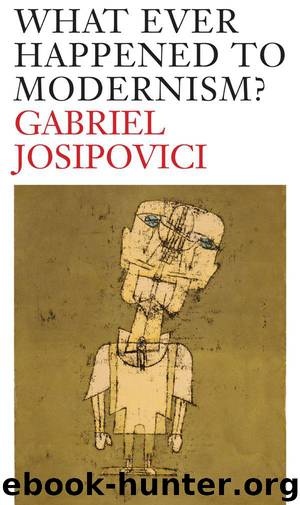What Ever Happened to Modernism? by Josipovici Gabriel

Author:Josipovici, Gabriel [Josipovici, Gabriel]
Language: eng
Format: mobi, azw3
Publisher: Yale University Press
Published: 2010-09-27T16:00:00+00:00
The other is ‘to understand the constant voicing of different positions as part of an ideological project and to try to identify which of these ideas is Dostoevsky's own’. The equivalent positions in relation to Picasso's collages are the ones that take them as representing the group of left-leaning friends talking round the coffee-table, and those that see them as projecting Picasso's own theory of newspapers as secret instruments for perpetuating the status quo. But both these are false conclusions, both deny the radical multivoicedness of Picasso's collage.
Though Bakhtin is helpful to Krauss at this juncture in her argument, I am not convinced that he quite makes the case he is trying to make for Dostoevsky. A reader of Krauss who had grown up with Eliot and Virginia Woolf, however, would have no difficulty in seeing what she was trying to do. Eliot himself, of course, tries to ‘re-monologise’ The Waste Land by suggesting, in his notes, that all that we are reading happens in the head of one of the characters mentioned in it, Tiresias; and there have been countless analyses of the poem which argue that what it ‘depicts’ is the fragmentation consequent upon the First World War. But Eliot's poem works precisely in the way Krauss suggests Picasso's collages do, and that the poet himself sensed this is suggested by the epigraph he originally intended to append to the poem, from Dickens: ‘He do the police in different voices.’ In the event he came upon something better, an epigraph that can and cannot be read (rather as the smaller fragments of type in Picasso's collages can and cannot be read: you need a magnifying glass), since it is in a mixture of Latin and Greek, and thus plays with the reader in the same way as do the other quotations and fragments of other languages embedded in the poem; for, deciphered, it touches on a central theme of the poem, death-in-life, but decipherment is also one of the key issues raised by the poem. The poem, like the 1912 Violin, flies off in different directions and slyly plays at the border between figure and ground, between our sense of incomprehension and our awareness that there is comprehension, but, to paraphrase Kafka, not for us.
To reconstitute the fragments is, in Kierkegaard's terms, to turn what is lived experience into thought experience, whereas both collage and poem explore what happens precisely when the one is turned into the other. The modern waste land, as Eliot describes it, is a place where thought and naked desire have taken the place of feeling and comprehension, which have almost completely atrophied. This situation, as we have already seen, is difficult to grasp precisely because to ‘grasp’ it is already to have lost it, to have become like the characters in all Eliot's early poems who can only think, not feel, who know too much but understand nothing.
A beautiful essay by John Mepham on Virginia Woolf's To the Lighthouse can help us in our own quest to understand.
Download
What Ever Happened to Modernism? by Josipovici Gabriel.azw3
This site does not store any files on its server. We only index and link to content provided by other sites. Please contact the content providers to delete copyright contents if any and email us, we'll remove relevant links or contents immediately.
Still Me by Jojo Moyes(11121)
On the Yard (New York Review Books Classics) by Braly Malcolm(5448)
A Year in the Merde by Stephen Clarke(5264)
Eleanor Oliphant Is Completely Fine by Gail Honeyman(5192)
The Bookshop by Penelope Fitzgerald(3721)
How Music Works by David Byrne(3081)
Surprise Me by Kinsella Sophie(3024)
Pharaoh by Wilbur Smith(2915)
Why I Write by George Orwell(2851)
A Column of Fire by Ken Follett(2522)
The Songlines by Bruce Chatwin(2471)
Churchill by Paul Johnson(2468)
The Beach by Alex Garland(2458)
Aubrey–Maturin 02 - [1803-04] - Post Captain by Patrick O'Brian(2239)
Heartless by Mary Balogh(2201)
Elizabeth by Philippa Jones(2127)
Hitler by Ian Kershaw(2099)
Harry Potter and the Cursed Child by J. K. Rowling & John Tiffany & Jack Thorne(2006)
Life of Elizabeth I by Alison Weir(1960)
